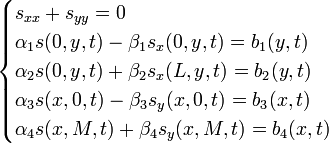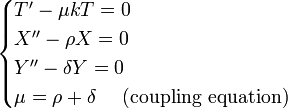Heat equation/Solution to the 2-D Heat Equation
< Heat equationDefinition
The solution to the 2-dimensional heat equation (in rectangular coordinates) deals with two spatial and a time dimension,  . The heat equation, the variable limits, the Robin boundary conditions, and the initial condition are defined as:
. The heat equation, the variable limits, the Robin boundary conditions, and the initial condition are defined as:
![\begin{align}
u_t=k \left [ u_{xx} + u_{yy} \right ] + h(x,y,t) \\
(x,y,t) \in [0,L] \times [0,M] \times [0,\infty) \\
\alpha_1u(0,y,t)-\beta_1u_x(0,y,t)=b_1(y,t) \\
\alpha_2u(L,y,t)+\beta_2u_x(L,y,t)=b_1(y,t) \\
\alpha_3u(x,0,t)-\beta_3u_y(x,0,t)=b_1(x,t) \\
\alpha_4u(x,M,t)+\beta_4u_y(x,M,t)=b_1(x,t) \\
u(x,y,0)=f(x,y)
\end{align}](../I/m/177191769bfad84fc63c1dde831c3ac6.png)
Solution
The solution is just an advanced version of the solution in 1 dimension. If you have questions about the steps shown here, review the 1-D solution.
Step 1: Partition Solution
Just as in the 1-D solution, we partition the solution into a "steady-state" and a "variable" portion:

We substitute this equation into the initial boundary value problem (IBVP):
![\begin{cases}
s_t+v_t=k \left [ s_{xx}+v_{xx}+s_{yy}+v_{yy} \right ] + h(x,y,t) \\
\alpha_1s(0,y,t)+\alpha_1v(0,y,t)-\beta_1s_x(0,y,t)-\beta_1v_x(0,y,t)=b_1(y,t) \\
\alpha_2s(0,y,t)+\alpha_2v(L,y,t)+\beta_2s_x(L,y,t)+\beta_2v_x(L,y,t)=b_2(y,t) \\
\alpha_3s(x,0,t)+\alpha_3v(x,0,t)-\beta_3s_y(x,0,t)-\beta_3v_y(x,0,t)=b_3(x,t) \\
\alpha_4s(x,M,t)+\alpha_4v(x,M,t)+\beta_4s_y(x,M,t)+\beta_4v_y(x,M,t)=b_4(x,t) \\
s(x,y,0)+v(x,y,0)=f(x,y)
\end{cases}](../I/m/fd9c88f9272543825cd08aaed7fea4ca.png)
We want to set some conditions on s and v:
- Let s satisfy the Laplace equation:

- Let s satisfy the non-homogeneous boundary conditions.
- Let v satisfy the non-homogeneous equation and homogeneous boundary conditions.
We end up with 2 separate IBVPs:

![\begin{cases}
v_t=k \left [ v_{xx}+v_{yy} \right ] + h(x,y,t) - s_t(x,y,t) \\
\alpha_1v(0,y,t)-\beta_1v_x(0,y,t)=0 \\
\alpha_2v(L,y,t)+\beta_2v_x(L,y,t)=0 \\
\alpha_3v(x,0,t)-\beta_3v_y(x,0,t)=0 \\
\alpha_4v(x,M,t)+\beta_4v_y(x,M,t)=0 \\
v(x,y,0)=f(x,y)-s(x,y,0)
\end{cases}](../I/m/36a8d4c4074a105d75af49e952eff3c9.png)
Step 2: Solve Steady-State Portion
Solving for the steady-state portion is exactly like solving the Laplace equation with 4 non-homogeneous boundary conditions. Using that technique, a solution can be found for all types of boundary conditions.
Step 3: Solve Variable Portion
Step 3.1: Solve Associated Homogeneous BVP
The associated homogeneous BVP equation is:
![v_t=k \left [ v_{xx}+v_{yy} \right ]](../I/m/1aae069d6e5648318bea2e57d51f39d7.png)
The boundary conditions for v are the ones in the IBVP above.
Separate Variables



By similar methods, you obtain the following ODEs:

Translate Boundary Conditions
![\left .
\begin{align}
\left [ \alpha_1X(0)-\beta_1X'(0) \right ] Y(y)T(t) & = 0 \\
\left [ \alpha_2X(L)+\beta_2X'(L) \right ] Y(y)T(t) & = 0 \\
\left [ \alpha_3Y(0)-\beta_3Y'(0) \right ] X(x)T(t) & = 0 \\
\left [ \alpha_4Y(M)+\beta_4Y'(M) \right ] X(x)T(t) & = 0
\end{align}
\right \} \Rightarrow
\begin{align}
\alpha_1X(0)-\beta_1X'(0) = 0 \\
\alpha_2X(L)+\beta_2X'(L) = 0 \\
\alpha_3Y(0)-\beta_3Y'(0) = 0 \\
\alpha_4Y(M)+\beta_4Y'(M) = 0
\end{align}](../I/m/6c963eeee7cb9bfff3a212d33f4a0660.png)
Solve SLPs


We have obtained eigenfunctions that we can use to solve the nonhomogeneous IBVP.
Step 3.2: Solve Non-homogeneous IBVP
Setup Problem
Just like in the 1-D case, we define v(x,y,t) and q(x,y,t) as infinite sums:


Determine Coefficients
We then substitute expansion into the PDE:
![\frac{\partial}{\partial t} \left [ \sum T_{mn}(t)X_n(x)Y_m(y) \right ] = k \left \{ \frac{\partial}{\partial x^2} \left [ \sum T_{mn}(t)X_n(x)Y_m(y) \right ] + \frac{\partial}{\partial y^2} \left [ \sum T_{mn}(t)X_n(x)Y_m(y) \right ] \right \} + \sum Q_{mn}(t)X_n(x)Y_m(y)](../I/m/39bf231e82c4104579a93c27cffc0e3e.png)

![\Rightarrow \sum T_{mn}'(t)X_n(x)Y_m(y) = \sum k \left \{ T_{mn}(t)[-\lambda_n^2X_n(x)]Y_m(y) + \sum T_{mn}(t)X_n(x)[-\hat{\lambda}_m^2Y_m(y)] \right \} + \sum Q_{mn}(t)X_n(x)Y_m(y)](../I/m/95330d15c4aea030a04905d06ff5493e.png)
![\Rightarrow \sum \left [ T_{mn}'(t)+k(\lambda_n^2+\hat{\lambda}_m^2) \right ] X_n(x)Y_m(y) = \sum Q_{mn}(t)X_n(x)Y_m(y)](../I/m/c9854ce9468f4c42deb35672b2293d8b.png)
This implies that  forms an orthogonal basis. This means that we can write the following:
forms an orthogonal basis. This means that we can write the following:

This is a first-order ODE which can be solved using the integration factor:

Solving for our coefficient we get:

Satisfy Initial Condition
We apply the initial condition to our equation above:

The Fourier coefficients can be solved using the inner product definition:
![C_{mn}=\frac{\int\limits_0^L \int\limits_0^M \left [ f(x,y)-s(x,y,0) \right ] X_n(x)Y_m(y) dy dx}{\int\limits_0^L X_n^2(x) dx \int\limits_0^M Y_m^2(y) dy}](../I/m/1fa3530eeb9ee936896d3ffed523a4fa.png)
We have all the necessary information about the variable portion of the function.
Step 4: Combine Solutions
We now have solved for the "steady-state" and "variable" portions, so we just add them together to get the complete solution to the 2-D heat equation.